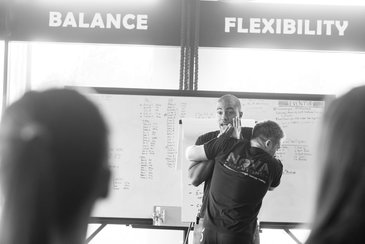A wise old man once said your training ingrains flaws and skills equally. That instructor’s impressive display ingrained, in himself and his students, two things: ineffective striking (he incapacitated neither student) and standing, unresponsive, when attacked suddenly. Seems dumb, right? But self-defense and martial arts are rife with these suboptimal practices.
Your training partner puts you in a headlock; you drive his chin back, “attack” his groin, and drop him. Great job! But why’d you let him grab you? You spent just as many reps allowing yourself to get grabbed as you did “defending”. Moreover, if you’d counterattacked with serious contact or commitment he’d be curled up on the floor. And what did your partner get out of that rep, acting practice?
Physical self-defense is practicing for a worst-case scenario: being forced to protect yourself by breaking other people. Effective training requires partners, posing at least two problems. First, broken people can’t train which means we either purposefully injure training partners or train not to hurt people; neither works. Second, half the time you’re both practicing losing badly because training ingrains habits into all participants. As the attacker, you train to attack once, usually without power or intent, and then passively take a “beating.” Why? Because, almost invariably, you want the defender to succeed. You’re ingraining training scars: counterproductive habits that condition acting ineffectively in desperate situations. The solutions lie in making conscious adjustments to make training both safe and effective.
-Go Slow- First, improve efficacy and safety by changing your speed. Slowing down is a great safety flaw (a conscious adjustment that keeps training dangerous moves from injuring participants) that promotes perfect mechanics, precise targeting, and full follow through without injury. Moving slowly also limits training scars: predators don’t kill slowly so, when partners attack, you’re not training yourself to ignore a serious threat. In the headlock counter example: practice the initial attack unthreateningly slowly and, once you both feel comfortable with how headlocks work, start defending them. Still slowly, have your partner try to headlock and, as soon as you see a threatening motion, do something about it. Gradually, let your partner apply the headlock more and more so you train counters at every point.
-Use Equipment- Equipment like pads and armor allows for striking with power and intent without doing serious harm to your partner. This avoids frequently seen training scars like pulled punches or practicing missing. When practicing headlock counters with your partner, have them position a pad or focus mitt near their groin so you train to strike with power and follow through.
-Move with Intent- This isn’t so much an adjustment as a principle. Whatever moves you’re doing should do damage if it were not for the safety flaw you’re using. You should strike with full intent to do damage and happen to be stopped by the pad or your partners block, etc. Training with intent enhance realism and helps find potential holes in safety protocols. So when you’re counterattacking from the headlock, use full intent so your partner has to defend themselves and you avoid a training scar.
-Train from Surprise- Practicing from surprise involves restricting visual or audio cues. With this you can counter at every stage of an attack without the training scar of ignoring assault indicators. Coming back to headlock counters, have your partner set up close to you with a pad arranged to protect his groin. Close your eyes and have your partner randomly head lock at full speed. React immediately to the aggressive touch and counterattack his groin. If your training partner is fast, you’ll be forced to counter the headlock at different points.
-Use Safety Officers- Safety officers serve as a useful adjustment. During many drills; especially as intention, energy, and skill increase; it becomes difficult to participate and be conscious of safety simultaneously. Many adjust for this by unconsciously employing bad habits but safety officers can maintain safety protocols without those bad habits.
-Involve Resistance- Attackers shouldn’t be practicing losing while defenders practice winning; you should be retaliating or, at least, fending. For example: when you’re the attacker applying the headlock, push your hips back to avoid the groin attack and cover up to fend off follow up strikes. To heighten the resistance, use specific techniques or defenses as precursors to modified sparring. Using head lock defense as an example again, set up with restricted vision and armor or pads. Have your partner initiate a headlock at full speed and counter as soon as you feel an aggressive touch. Once you’ve responded, a very brief modified sparring session should begin, allowing both parties to practice attacking and defending. Fending and sparring have obvious value for the attacker but also keep the defender from creating unrealistic expectations of how fights will go.
-Keep it Quick- Limiting drills’ duration is a final useful adjustment. By limiting time, you can do three things: prevent injuries, avoid artificially induced safety, and keep participants from “winning” or “losing”. For you to win, your partner must lose creating training scars for at least one partner. If the drill ends quickly, however, partners are less likely to get hurt or have a definitive “win” and can develop intensity while maintaining good habits. Safety officers can help with limiting time appropriately.
So, is practicing headlocks the point? Absolutely not; the point is training thoughtfully. Notice that these safety flaws counterbalance each other, creating a robust training method without major holes and avoidant of training scars. Conscious adjustments and safety flaws should always exist but creativity can blend them to your advantage.
Be dangerous, train safely,
Coach Malcolm
NOVA Self Defense

 RSS Feed
RSS Feed